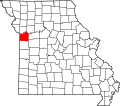Independence, Missouri | |
|---|---|
 Jackson County Courthouse in Independence | |
 Location of Independence in Missouri | |
| Coordinates: 39°04′42″N94°25′10″W / 39.07833°N 94.41944°W | |
| Country | United States |
| State | Missouri |
| Counties | Jackson, Clay |
| Founded | March 29, 1827 |
| Named after | The Declaration of Independence |
| Government | |
| • Mayor | Rory Rowland (D) |
| • City Manager | Zachary C. Walker |
| Area | |
• Total | 78.42 sq mi (203.10 km2) |
| • Land | 77.97 sq mi (201.93 km2) |
| • Water | 0.45 sq mi (1.17 km2) |
| Elevation | 863 ft (263 m) |
| Population (2020) | |
• Total | 123,011 |
| • Density | 1,577.7/sq mi (609.17/km2) |
| Demonym | Independencian |
| Time zone | UTC−6 (Central (CST)) |
| • Summer (DST) | UTC−5 (CDT) |
| ZIP Codes | 64050–64058 |
| Area codes | 816, 975 |
| FIPS code | 29-35000 [3] |
| GNIS feature ID | 2395422 [2] |
| Website | www |
Independence is a city mostly in and one of two county seats of Jackson County, Missouri, United States. [4] It is a satellite city of Kansas City, Missouri, and is the largest suburb on the Missouri side of the Kansas City metropolitan area. In 2020, it had a total population of 123,011, making it the fifth-most populous city in Missouri. A small part of the city extends into Clay County. [5]
Contents
- History
- Geography
- Demographics
- 2020 census
- 2010 census
- 2000 census
- Religion
- Economy
- Top employers
- Government
- Education
- Primary and secondary
- Colleges and universities
- Libraries
- Media
- Newspapers
- Television
- Magazines
- Culture
- Museums
- Sports
- Sister city
- Infrastructure
- Highways and roads
- Hospital
- Transportation
- Utilities
- Notable people
- See also
- References
- External links
Independence is known as the "Queen City of the Trails" [6] because it was a point of departure for the California, Oregon, and Santa Fe Trails. It is the hometown of U.S. President Harry S. Truman, with the Truman Presidential Library and Museum, and the gravesites of Truman and First Lady Bess Truman. The city is sacred to the Latter Day Saint movement, as the home of Joseph Smith's 1831 Temple Lot, and the headquarters of several Mormon denominations.







